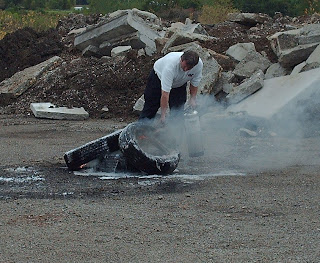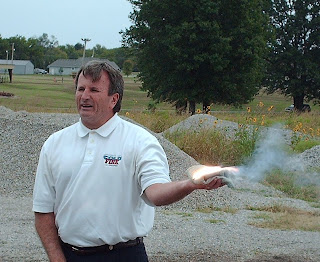Let's say for example, a sheriff's deputy is first on the scene of an accident- a mangled car that is starting to burn with a victim trapped inside . A normal response would be to get a fire department in route asap and in the mean time attack the flames with a 'dry type' fire extinguisher. One problem is that a dry type extinguisher has a somewhat limited ability when fighting fires fueled by plastic and gasoline. Plus the powder from a dry type extinguisher can choke the trapped victim. Even if the fire is put out, there will be a lot of residual heat making extraction of the victim tricky.
Take the same scenario except this time the deputy is armed with a Cold Fire extinguisher. The fire is put out much quicker than by using water or a dry type extinguisher; there's no powder to choke the victim; the victim can be sprayed with the product, covering them with a 'heat shield'; now the metal and plastic burning just a few moments ago is cool to the touch, making is much easier to assess or extract the victim. In some cases, the fire department may have very little firefighting to do when they arrive.
To show exactly how good Cold Fire works, representative Ed McFadden joined a large group at the Bates County Fairgrounds today for a demonstration. As shown in the photos below, Cold Fire lives up to it's name:
 |
Burning tires are tough to put out by traditional means. Over the next two photos, Cold Fire makes short work putting out the fire: |
After today's demonstration the Cold Fire extinguishers were installed in the patrol cars and officers received training on the product.
For more information visit the Cold Fire web site here.
 |
| The entire process took less than 30 seconds |
 |
| Sheriff Chad Anderson and Cold Fire representative Ed McFadden |
 |
| Cold Fire extinguishers are refilled by the user. Sheriff's Deputies received training on how to properly use and handle the product as it was placed on our county patrol cars today. |






